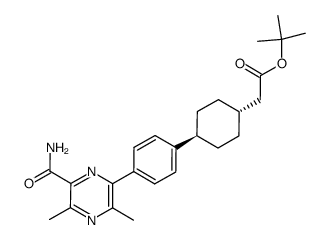1166827-44-6
| Name | 2-[4-[4-(6-carbamoyl-3,5-dimethylpyrazin-2-yl)phenyl]cyclohexyl]acetic acid |
|---|---|
| Synonyms |
{trans-4-[4-(6-carbamoyl-3,5-dimethylpyrazin-2-yl)phenyl]cyclohexyl}acetic acid
2-((1r,4r)-4-(4-(6-carbamoyl-3,5-dimethylpyrazin-2-yl)phenyl)cyclohexyl)acetic acid AZD7687 |
| Description | AZD7687 is a potent and selective DGAT1 inhibitor with an IC50 value of 80 nM (hDGAT1).IC50 value: 80 nM [1]Target: DGAT1in vitro: Plasma AZD7687 exposure was measured repeatedly. Postprandial serum TAG excursion was measured during 8 h after a standardized mixed meal with fat energy content of 60% (SMM 60%; five cohorts, 1-20 mg), before (baseline) and after dosing, to assess effects on gut DGAT1 activity. AZD7687 markedly reduced postprandial TAG excursion with a steep concentration-effect relationship [2].in vivo: Multiple doses of AZD7687 (1, 2.5, 5, 10 and 20 mg/day, n=6 or n=12 for each) or placebo (n=20) were administered for 1 week. Dose-dependent reductions in postprandial serum TAG were demonstrated with AZD7687 doses ≥5mg compared with placebo (p<0.01). Significant (p<0.001) increases in plasma GLP-1 and PYY levels were seen at these doses, but no clear effect on gastric emptying was demonstrated at the end of treatment. With AZD7687 doses >5 mg/day, gastrointestinal (GI) side effects increased; 11/18 of these participants discontinued treatment owing to diarrhoea [3]. |
|---|---|
| Related Catalog | |
| References |
| Molecular Formula | C21H25N3O3 |
|---|---|
| Molecular Weight | 367.44200 |
| Exact Mass | 367.19000 |
| PSA | 107.16000 |
| LogP | 4.49200 |
| Storage condition | 2-8℃ |
|
~99% 
1166827-44-6 |
| Literature: ASTRAZENECA AB; ASTRAZENECA UK LIMITED Patent: WO2009/81195 A1, 2009 ; Location in patent: Page/Page column 51 ; WO 2009/081195 A1 |
|
~80% 
1166827-44-6 |
| Literature: ASTRAZENECA AB; ASTRAZENECA UK LIMITED Patent: WO2009/81195 A1, 2009 ; Location in patent: Page/Page column 168-169 ; WO 2009/081195 A1 |

